Top 10 Military Trucks in the World
Which is the best military trucks in the world? Which is the greatest military truck and why? There are hundreds and thousands of various truck models, that are being used for military service. Some of them are commercial designs, just repainted in military colors. The others are purpose-built tactical vehicles, that where specially designed for military use. Main roles of military trucks are to carry soldiers and supplies.
Key factor for this Top 10 analysis is how long a basic design without significant changes is being produced, as well as combination of payload capacity, cross-country mobility, reliability production numbers, and some other factors.
This Top 10 list includes only operational trucks. It do not includes vehicles that are being developed or received no production orders.
Currently Top 10 military trucks in the world are these:
1 Mercedes-Benz UNIMOG (Germany)
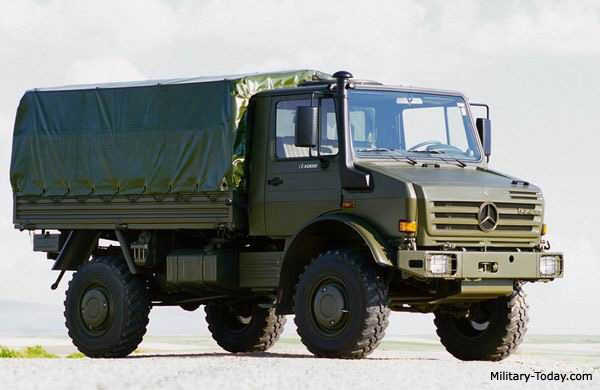 The first Mercedes-Benz UNIMOG (Universal Motor Gerat) was designed in 1946, shortly after the World War II. Prototypes were revealed in 1948. It was originally designed as a simple and efficient multi-purpose machine with a permanent 4×4, that could used for agriculture, forestry, and transportation of various cargo. Its design proved to be extremely successful. This heavy-duty truck is produced ever since. That’s nearly 70 years! Furthermore over the years the basic design of this vehicle has remained constant. The UNIMOG range has been expanded to encompass a family of 4×4 utility trucks with off-road payloads of between 1 250 and 7 500 kg. These is even a 6×6 version. This vehicle is available both for military and civilian applications. The UNIMOGS have been exported to all over the world and they are license-produced in some countries. These military trucks are used used by at least 30 countries.
The first Mercedes-Benz UNIMOG (Universal Motor Gerat) was designed in 1946, shortly after the World War II. Prototypes were revealed in 1948. It was originally designed as a simple and efficient multi-purpose machine with a permanent 4×4, that could used for agriculture, forestry, and transportation of various cargo. Its design proved to be extremely successful. This heavy-duty truck is produced ever since. That’s nearly 70 years! Furthermore over the years the basic design of this vehicle has remained constant. The UNIMOG range has been expanded to encompass a family of 4×4 utility trucks with off-road payloads of between 1 250 and 7 500 kg. These is even a 6×6 version. This vehicle is available both for military and civilian applications. The UNIMOGS have been exported to all over the world and they are license-produced in some countries. These military trucks are used used by at least 30 countries.
Over the years many models have been introduced and body styles have altered considerably but all versions are tough and efficient vehicles with excellent cross country performance capabilities. There are varying wheelbases, engine capacities and outputs, load area dimensions and many other variables to ensure that there is a UNIMOG to meet any particular military logistics requirement. These trucks are used as troop carriers, ambulances, equipment carriers, command vehicles and for many other specialized roles. UNIMOGS are also used as light artillery tractors.
These military trucks are entirely conventional in design. All UNIMOGS have diesel engines. A number of engines are available for these vehicles. These trucks are capable of operating off-road, in deep water, mud or snow. A central tyre inflation system is proposed as an option. The UNIMOGs are as capable off-road as most purpose-designed tactical vehicles. However it has an advantage as its parts are readily available all over the world.
A number of armored vehicles are based around the automotive components of this utility truck. These include Aravis, Dingo I, Dingo II and Mamba mine protected vehicles, Condor and AV-VBL armored personnel carriers.
2 M1078 LMTV and M1083 MTV family of trucks (United States)

In 1991 a Stewart & Stevenson company was awarded a large-scale contract to manufacture the US Army’s new Family of Medium Tactical Vehicles (FMTV) with the intention that eventually all the existing (and ageing) medium trucks in the Army’s inventory would be replaced by a modern and efficient design. First production vehicles were delivered to the US Army in 1996 and replaced the ageing designs, such as the M809 and M35, which traced traced its origins back to the late 1940s. Since 2012 the FMTV family of trucks is produced by the Oshkosh Corporation.
The FMTV is based on an Austrian Steyr 12M18 truck, which was produced since 1985, but considerably reengineered to be available as the 4×4 Light Medium Tactical Vehicle (LMTV) and the 6×6 Medium Tactical Vehicle (MTV). Both models have over 90 percent of components in common such as the cab, engine, drive train, tyres, wheels, front suspension, axles, etc, while this design involves many commercially available components. The basic LMTV is the M1078 cargo truck while the 6×6 basic model is the M1083.
Accent of these vehicles has been on reliability, low unit and running costs, and long term efficiency. All aspects were well demonstrated during its service life.
These military trucks are designed to transport cargo and soldiers. It is the main workhorse of the US Army. This family of military trucks is destined to serve well into the 21st Century and is being offered for export sales in the Far East and elsewhere.
Experience in Iraq led to development of an armored cab. It is known as Low Signature Armored Cab (LSAC). Two man team can remove and replace a standard cab by an armored cab in the field within 4 hours. Later a new Long Term Armor Strategy (LTAS) armored cab appeared. It can adapt various armor levels, depending on the threat.
3 MAN SX series (Germany)
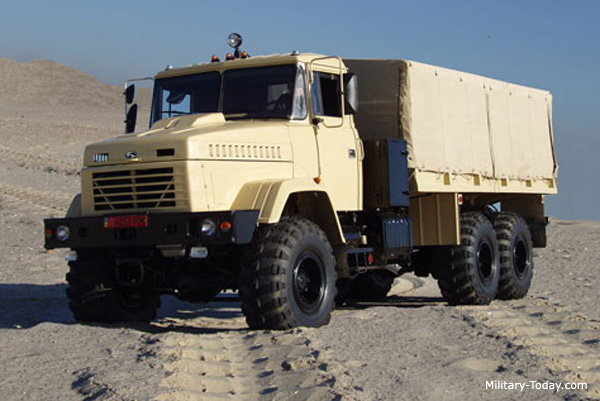
The MAN SX series of high mobility military trucks is a successor to the previous KAT 1, which was introduced with the German armed forces in the late 1960s. These military vehicles can be easily identified by their vertical windscreens. The MAN SX series vehicles are in service with Germany, Austria, Denmark, Malaysia, Norway, Sweden, United Kingdom and some other countries.
The MAN SX series high mobility truck shares some technologies with the MAN HX family, as well as FX and LX families. However it has a stiffer chassis and much greater mobility. The SX45 is an 8×8 heavy utility truck, designed to operate in tough off-road conditions. It has a payload capacity of 14 – 16 t. There is also a smaller SX44 with 6×6 configuration. These trucks were specially developed to meet military requirements and are intended to carry heavy and specialized equipment, such as radars, command shelters, antenna masts, missile launchers and so on. It is also used as a load handling system to carry flatracks and containers. There are light and heavy recovery versions of this vehicle as well.
The MAX SX family has a modular cab, which can be fitted with add-on armor protection kit. This kit was jointly developed by MAN and Krauss-Maffei Wegmann. It provides protection against small arms fire, artillery shell splinters, grenades, small anti-personnel mines. Armored modules are attached to the outside of the cab. Armored kit can be installed within 10 hours in field conditions. The MAN SX series trucks are also available with an integrated armored cab, which offers higher level of protection. It can be even equipped with remotely controlled weapon station.
Another unusual feature of this military truck is that engine is located behind and under the cab. Such layout allowed to reduce overall height of the truck. Furthermore the radiator is located behind the cab and can not be easily damaged or blocked with mud. This high mobility truck was designed to keep pace with tracked combat vehicles across any terrain.
Developers claim, that the MAN SX are the most mobile and reliable military trucks currently on the market. The MAN SX series trucks have a service life of 30 years.
There is also MAN HX series. These vehicles were also specially developed to meet military needs and are intended for off-road applications.
4 Ural-4320 (Russia)
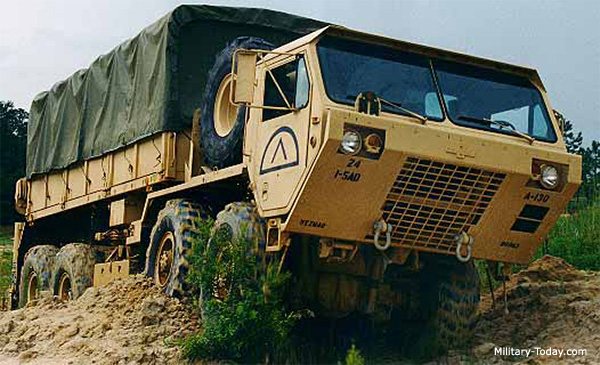
The Ural-4320 is a Russian heavy off-road truck. It follows the lines of the Ural-375 which entered production back in 1961. The Ural-4320 is produced without significant changes since 1976. It is a heavy-duty cargo vehicle, which is available both for civil and military customers. This truck is in service with the Russian military as well as many other countries. It can be often spotted in various military conflicts.
This vehicle is entirely conventional in design and technology. It has a payload capacity of 4.5 t off-road and 6 t on hard surface roads. A basic version is a troop/cargo carrier. This military truck also tows trailers or artillery pieces. Though many versions of this vehicle with various bodies exist. However this Russian truck is not as reliable as its Western counterparts.
The Ural-4320 has a full-time all wheel drive and is fitted with a centralized tyre pressure system. It is an extremely capable off-road vehicle. With preparation all models can ford water obstacles up to 1.75 m deep. Vehicle can operate in climatic conditions, ranging from -50°C to +50°C.
5 KrAZ-6322 (Ukraine)

The KrAZ-6322 is a Ukrainian heavy utility truck. It evolved from the previous KrAZ-255 and 260 models, but has been upgraded to meet today’s standards. It is a reliable and proven design. The KrAZ-6322 is produced since 1999. Though its predecessors trace their origins to the 1960s and even earlier. This military truck is in service with Ukraine, Angola, Egypt, India, Indonesia and Yemen. A large number of these military trucks were ordered by the US Government for the new Iraqi Army. It is also in service with Iran and possibly some other countries.
The KrAZ-6322 heavy truck has a payload capacity of over 10 t. Vehicle can tow a trailer with a maximum weight of up to 30 t. It can also tow aircrafts with a maximum weight of up to 75 t on the airfields.
This heavy-duty military truck is intended for different loads and troop transportation. Basic design can accept a wide variety of body types. The standard body is fitted with drop sides and a removable tarpaulin with bows. Wooden bench seats may be fitted for troop transportation. Vehicle can carry up to 24 troops. A three-person cab is standard across the range. It is very similar to that of the earlier KrAZ-260.
This military truck was specially designed for off-road application and has considerable cross-country mobility.
The KrAZ-6322 is proposed in a number of variants.
6 MTVR (United States)
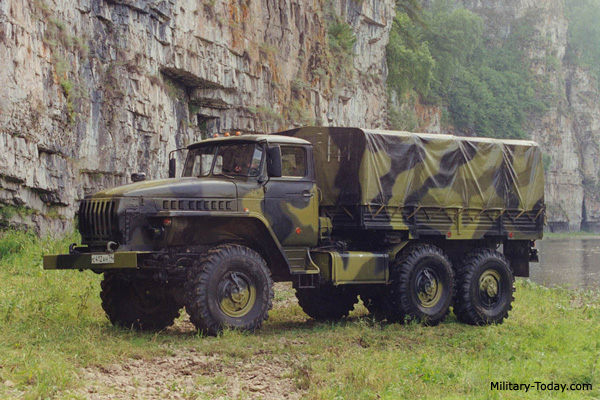
The Medium Tactical Vehicle Replacement, or MTVR, is a purpose-designed military truck. The It was developed by Oshkosh. It was first fielded in 1998 and entered full-scale production in 2005. This vehicle is used by the US Navy and Marine Corps. It replaces the M939 6×6 truck and the ageing M809 6×6 truck, that was produced between 1970 and 1982. The new truck offers greater mobility, payload and reliability. Over 11 000 MTVR trucks were delivered. It has been exported to Egypt, Greece, Iraq, the United Kingdom, and possibly some other countries.
All versions of the MTVR use the same 6×6 configuration. Engine is located under a forward fiberglass bonnet. Roof of the cab with hinged aluminum windscreen and door frames can be folded down to reduce overall height of the vehicle. The Mk.23 is the standard cargo variant.
This heavy utility truck can carry a payload of 7 t off-road or up to 15 t when driving on smoother surfaces, while simultaneously being able to tow an 11 t load. The MTVR is highly adaptable for any cargo hauling, carrying or winching. Its wide versatility makes the MTVR an integral part of the Marine Corps logistical backbone. This vehicle is the prime mover for the M777 howitzer, troops, fuel, water and a wide variety of other equipment.
The MTVR truck can be fitted with armor protection kit or armed with a 12.7 mm or 7.62 mm machine gun.
The MTVR trucks are powered by the Caterpillar C-12 11.9-liter turbocharged diesel engine, developing 425 hp. Vehicle has a full-time all-wheel drive with an independent suspension system, as well as a central tyre inflation system. This military truck has good cross-country performance.
7 KamAZ-5350 (Russia)
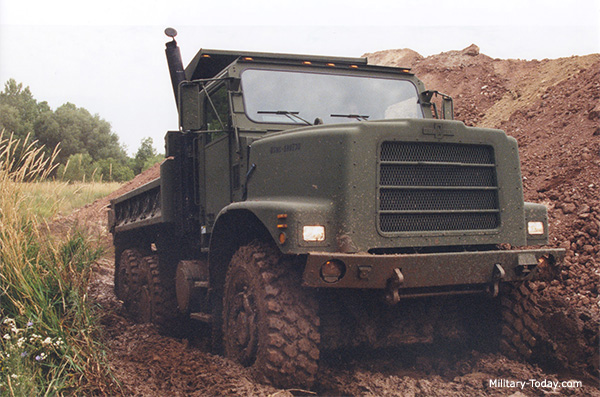
The KamAZ-5350 is another Russian military truck. It is a follow-on to the KamAZ-4310, which was produced since 1980 and was the workhorse of the Soviet military. The KamAZ-5350 is produced since 2003. This truck is available both for civil and military customers.
This military truck has a conventional layout, with a front-mounted engine and a forward control cab. A baseline version has a general troop/cargo body with folding-down sides and tailgate. However this truck is also available with a number of body styles. Also there are versions with 4×4 and 6×6 configurations.
Its payload on cross-country terrain is limited to 6 t. It can also tow trailers or artillery pieces with a maximum weight up to 7 t.
Vehicle has a full-time all-wheel drive and is fitted with a central tyre inflation system.
8 HEMTT (United States)
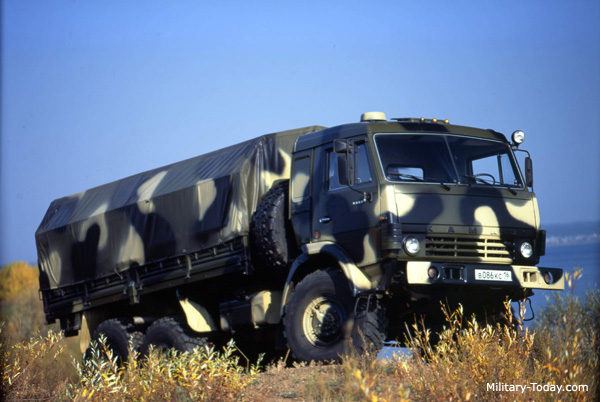
The HEMTT or Heavy Expanded Mobility Tactical Truck is a family of 8×8 heavy high-mobility trucks produced by Oshkosh and used by the US military. The HEMTT entered service with the US Army in 1982 and replaced the ageing M520 Goer. Over 15 000 of these high mobility trucks were built. These are also referred as Family of Heavy Tactical Vehicles or FHTV. These vehicles are rapidly deployable and are designed to operate in any climatic conditions.
There are a number of variants of the HEMTT trucks, built on a similar chassis and equipped to perform different missions. These high mobility trucks are used by the US military to perform local and line haul, unit resupply and related tactical missions. The M977 is a baseline cargo truck, fitted with material handling crane. This particular model was produced in large numbers.
Cab of the HEMTT may be fitted with add-on armor kit. It protects the crew from small arms fire and artillery shell fragments. There is a machine gun mount on top of the roof.
Vehicle is powered by the Detroit Diesel 8V92TA turbocharged diesel engine, developing 450 hp. Engine is located behind the cab. Such layout allowed to reduce overall height of the vehicle. Engine is coupled to an automatic transmission. This military truck has 8×8 configuration, however it can be switched to 8×4 on hard surface roads for maximum speed and range. Vehicle has great cross-country mobility.
There are upgraded versions, such as HEMTT A3 and HEMTT A4, with significantly increased capabilities.
The US Marine Corps used an Mk.48 LVS or Logistics Vehicle System. This tactical truck is nicknamed the Dragon Wagon. It is an articulated 8×8 vehicle, which shares many similarities with the HEMTT. For a number of years it was a mainstay of the USMC logistical fleet.
9 LVSR (United States)
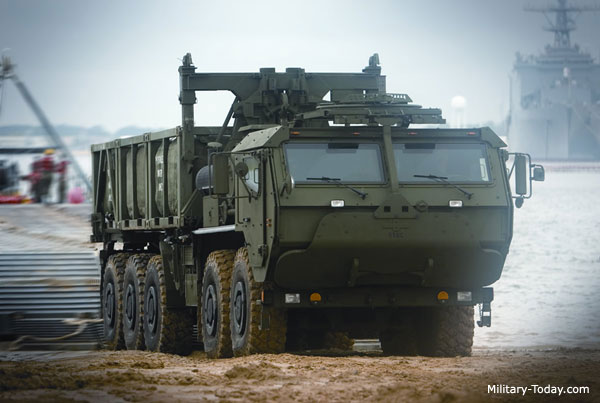
In 2006 the US Marine Corps selected the Oshkosh LVSR (Logistic Vehicle System Replacement) heavy tactical trucks to replace the ageing Oshkosh Mk.48 series, which was launched in 1985 and was the mainstay of the USMC logistics fleet. This truck is similar in concept to the US Army Palletized Load System (PLS). Overall USMC requirement is for over 2 000 heavy high mobility trucks, including variants. First production vehicles were delivered in 2009. In the same year these heavy trucks were deployed in Afghanistan.
The main function for this heavy utility truck is to transport heavy engineering and combat equipment, containers and basic supplies, such as ammunition, fuel and water. This 10×10 vehicle has a payload capacity of about 12 t off-road and 20.4 t on hard surface roads. It can also tow a trailer or artillery pieces.
The Oshkosh LVSR trucks are capable of meeting the operational requirements of Marine Corps expeditionary missions throughout the world. It is fitted with an integrated armored cab and energy-absorbing seats. Add-on armor kit can be fitted for a higher level of protection.
The Oshkosh LVSR shares a number of automotive components with the Oshkosh MTVR heavy utility truck. It is powered by a Caterpillar C15 turbocharged diesel engine, developing 600 hp. Engine is located behind and under the cab. Such layout allowed to reduce height of the vehicle. Also such design protects damage of the radiator or blockage with mud. Vehicle has a full time all-wheel drive and is fitted with a central tyre inflation system. The LVSR has good cross country mobility over any terrain.
10 IVECO M250 (Italy)
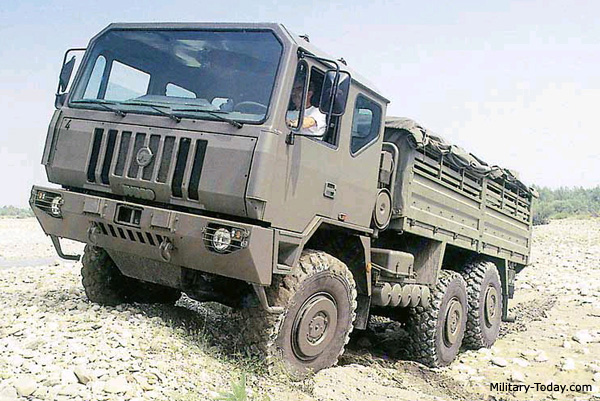
The Italian IVECO company has long tradition for building dedicated military trucks. The IVECO M250 is a recent series of tactical trucks, that were designed to operate on all kinds of roads and off-road. The M250 is a 6×6 version, while there are also M170 4×4 version and M320 8×8 version. There is a 66% commonality of components across the range of these tactical military trucks. These trucks are branded ASTRA for domestic market while the M250 is its export designation. It seems that deliveries to the Italian Army commenced in 2003. These trucks were exported to Belgium, Spain, and possibly some other countries. The Spanish trucks are badged as IVECO-Pegaso.
These tactical trucks fulfill logistic roles both for frontline and rear echelon units. The IVECO M250 series trucks are available with various wheelbase lengths. Payload capacity also varies depending on the version. The M250.45WM has a payload capacity of 8 000 kg. It can also tow trailers or artillery pieces. The baseline version is a cargo/troop carrier. This military truck is fitted with a standard drop side cargo body, with bows and tarpaulin cover. Also it can accept a variety of other bodies. Specialized versions are available, such as artillery tractor, dump truck, load handling system and tractor truck which hauls Centauro fire support vehicles.
The Iveco M250 series trucks are fitted with a purpose-designed military cabs. The cab has sleeper berths. It accommodates driver and up to three passengers. Cabs of the Belgian trucks are protected against landmines. An add-on armor kit, which features internally-mounted replacement panels, can be installed. It provides protection against small arms fire and artillery shell splinters.
Belgian trucks are powered by Iveco Cursor-13 turbocharged diesel engine, developing 450 hp. Another engine model, developing 400 hp is available. A number of automotive components are from Iveco EuroTrakker range of commercial trucks. Vehicle has a full-time all-wheel drive and is fitted with a central tyre inflation system.
The M250 military trucks can be airlifted by the C-130 Hercules tactical airlifter after a short preparation.



















